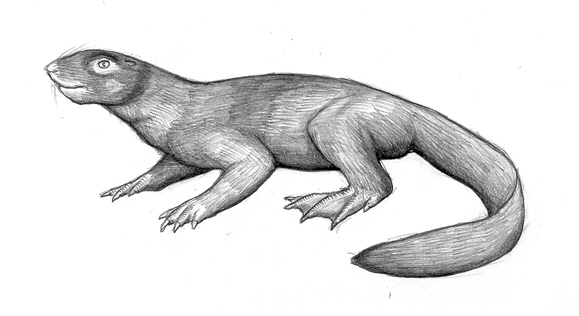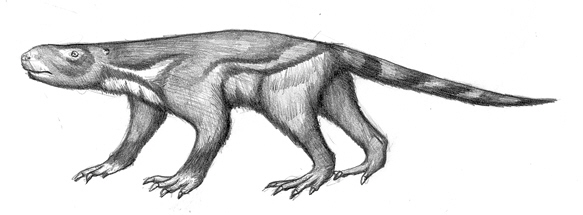BIOLOGY[]
This clade of basal, sprawling, often weasel-like mammals has a glorious Mesozoic history, compared to the small number of known species. It brought forth the earliest carnivorous mammals, as well as the first ones to reach the size of a baskerville, as the mighty Repenomamus did in the middle Early Cretaceous. After that time their fossils become rare. Only in South America can it be said with some confidence that they reached the end of the Cretaceous. This rarity of fossils is it what makes Spec's trikes so interesting for the mammalogists, in spite of their impenetrable habitat, the rainforests of South and Central America. Reports of a trike in the just as impenetrable rainforest of Madagascar are unconfirmed and could refer to a big predatory marsupial or who knows what. Only now do we know, for example, that trikes lay eggs, in fact only one very big egg at a time, which may have contributed both to their survival and to their rarity and restricted distribution. Males have the poison spur on the ankle that is so common among basal mammals. Trikes still have the famous triconodont dentition, which means that their canines are surprisingly small for a carnivore, while their molars have three cusps of more or less equal size arranged in a line - a specialization for cutting meat. Indeed, trikes appear to be almost exclusively carnivorous, though small species will also take insects. Reports of trikes eating fallen fruits are unconfirmed. Interestingly, all known trikes live on the ground, there are no climbers among them. Their claws are rather short and blunt, which, together with their long legs, makes them swift runners. At least some species are good swimmers; a swimming trike looks much like a swimming iguana, or an each-uisge lying on a side, because trikes use lateral undulations and their big feet to move water.
EUICHTHYOCONODONTIDAE (Otter trikes)[]
The river systems of northern and central South America are teeming with life. Most of it is ultimately eaten by crocodiles, but there is also a mammal among the big predators.
Otter Trike (Euichthyoconodon enantilutra)[]
The little known otter trike (Euichthyoconodon enantilutra) can apparently reach 2.5 m in total length, continuing the triconodont tradition of being obscenely big for a mammal. It is a diurnal, selkie-like predator that eats pretty much everything that moves and isn't too big or strongly armored.
At first sight the otter trike it looks more like a crocodile, because it swims primarily by lateral undulations of its long body and long, flattened tail. Hands and feet are large and webbed, but used mainly for steering and braking, as well as for walking and running croc-style on land. One spexplorer claims to have seen an otter trike that, pursued by a jagular, headed for the next tree in long leaps, much like a galloping crocodile, and climbed up there despite its rather short and broad claws. However, said spexplorer has injured his head badly while trying to escape from said jagular, so some don't consider his account reliable.
Otter trikes nest in long, deep burrows. Not much more is known because the burrows are guarded by the males which, as usual for basal mammals, are equipped with formidable poison spurs. The poison hurts maddeningly - a similarity to RL's other otters.
Other Taxa:
- Tayra trike (Eiraconodon barbatus)
- Dog-headed trike (Speothoconodon cynoides)
,=Eiraconodon barbatus (Tayra trike)
,=Austriotirconodontidae=|
| `=Speothoconodon cynoides (Dog-headded trike)
Eutriconodonta=|
`=Euichthyoconodon enantilutra (Otter trikes)


